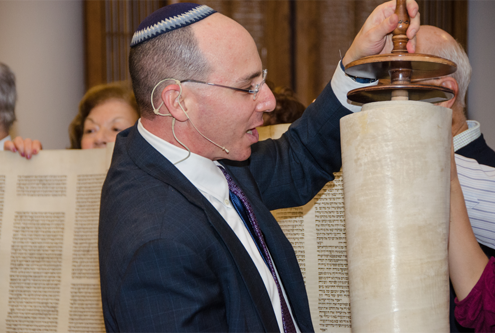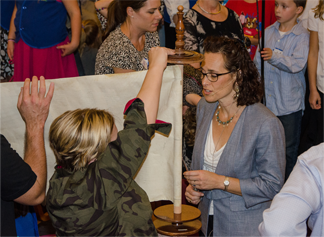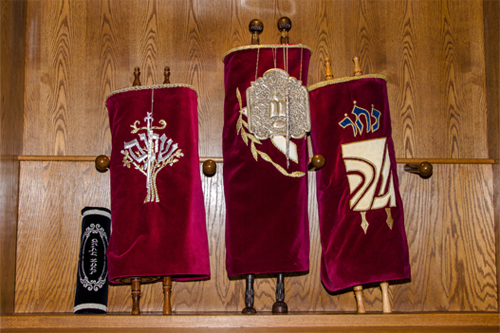Central to Jewish tradition is Torah, which contains the teachings of Judaism. Torah refers to the Five Books of Moses (Genesis, Exodus, Leviticus, Numbers, and Deuteronomy which were given on Mount Sinai) and more broadly to the Oral Law (which is contained in the Talmud and Midrash). A Sefer Torah, or Torah scroll, is a handwritten copy of the Five Books of Moses.
NVHC has three Sifrei Torah. Our youngest scroll is about 125 years old and originated in Eastern Poland or Ukraine and was brought to NVHC via Samarkand, Uzbekistan. It is the heaviest of the three scrolls. The second oldest is between 150-175 years old and comes from Poland. This is the one we read most often and is the lightest and the newest addition to the NVHC collection of Torah scrolls. The oldest is our Czech Holocaust scroll which is likely 250-300 years old. Because of its delicate condition, we read this scroll only on special occasions (usually the afternoon of Yom Kippur). It has beautiful handwriting, intricately carved handles and an amazing story (see below).
The Sifrei Torah are stored in an ark. NVHC has an ark in our sanctuary and a portable ark for when services are held in another location.
Our Holocaust Torah Scroll
One of NVHC’s Torah scrolls is on loan from the Memorial Scrolls Trust, a collection of Torah scrolls from Czechoslovakia which survived the Holocaust.
In the 1930s, Bohemia and Moravia in Czechoslovakia had over 350 Jewish Congregations and close to 120,000 Jews. As the Germans invaded in 1939, these communities were either destroyed or deserted. In 1942, a group of Jews working in a museum in Prague convinced the Nazis to bring religious treasures from deserted communities and destroyed synagogues to the comparative safety of Prague. More than 100,000 artifacts (including about 1,800 Torah scrolls) were brought to what would become the Central Jewish Museum in Prague. The Jewish curators hoped that eventually the artifacts and scrolls could be returned to their communities. All the curators were eventually transported to Terezin and Auschwitz. Only one curator survived. After the war, the Czech Jewish community was too depleted to be able to care for the scrolls properly, and they languished in storage.
In 1963, a London art dealer purchased 1,564 Torah scrolls stored by the Jewish Museum of Prague. Through the generosity of Ralph Yablon and the efforts of the congregation at Westminster Synagogue, the entire collection was transported to London in 1964. These scrolls became the Memorial Scrolls Trust.
While some of the Torah scrolls were damaged beyond repair, many were usable with some restoration by a sofer (scribe). Rather than sit in a museum, most of these scrolls were returned to Jewish life as long-term loaners to congregations throughout the world.
NVHC received our memorial scroll (MST #601) in 1970. This scroll was originally used by the Jewish community in Hermanuv Mestec, located in the Czech Republic about 54 miles east of Prague. Because of its delicate condition it is read only on special occasions. If a Jewish community arises in Hermanuv Mestec again, NVHC would return the scroll for their use. Another scroll from Hermanuv Mestec is in use by Congregation Beth El in Bethesda. Rabbi Emerita Rosalind Gold and her husband Ted Smith visited Hermanuv Mestec in 1993. Ted visited again in 2000. Click here to read an essay on Ted’s research.
The memorial scrolls connect today’s congregations with Jewish communities that were lost in the Holocaust. By the continued use of these sacred texts for study and worship, the destroyed Jewish communities live on.
Sefer Torah
 A Sefer Torah is a handwritten copy of the Five Books of Moses used for study and ritual readings. It is stored in a sacred place within the synagogue, called an ark.
A Sefer Torah is a handwritten copy of the Five Books of Moses used for study and ritual readings. It is stored in a sacred place within the synagogue, called an ark.
A Sefer Torah is written in Hebrew and meticulously copied by a scribe (known as a sofer) using a quill pen dipped in ink onto parchment. Parchment panels are connected together with hair or sinew. All of these materials must come from ritually clean animals. The entire document is rolled around wooden handles.
The sofer precisely duplicates the text in a process that can take over a year. No uncorrected errors are permitted.
In Ashkenazi tradition, Sefer Torah are robed in fabric and can be ornamentally decorated with crowns and breast plates. NVHC’s Czech Holocaust scroll has a silver breast plate.

A Sofer (or scribe) at work on a Sefer Torah
A sofer also transcribes other religious writings including tefillin and mezuzot. By tradition they must be observant Jews, of good character, and scholarly. They study for years under a master sofer.

A section of text from a Sefer Torah
A pointer or yad (literally hand in Hebrew) is used to mark one’s place while reading from a Sefer Torah to avoid smudging text with the oil from our fingers.



